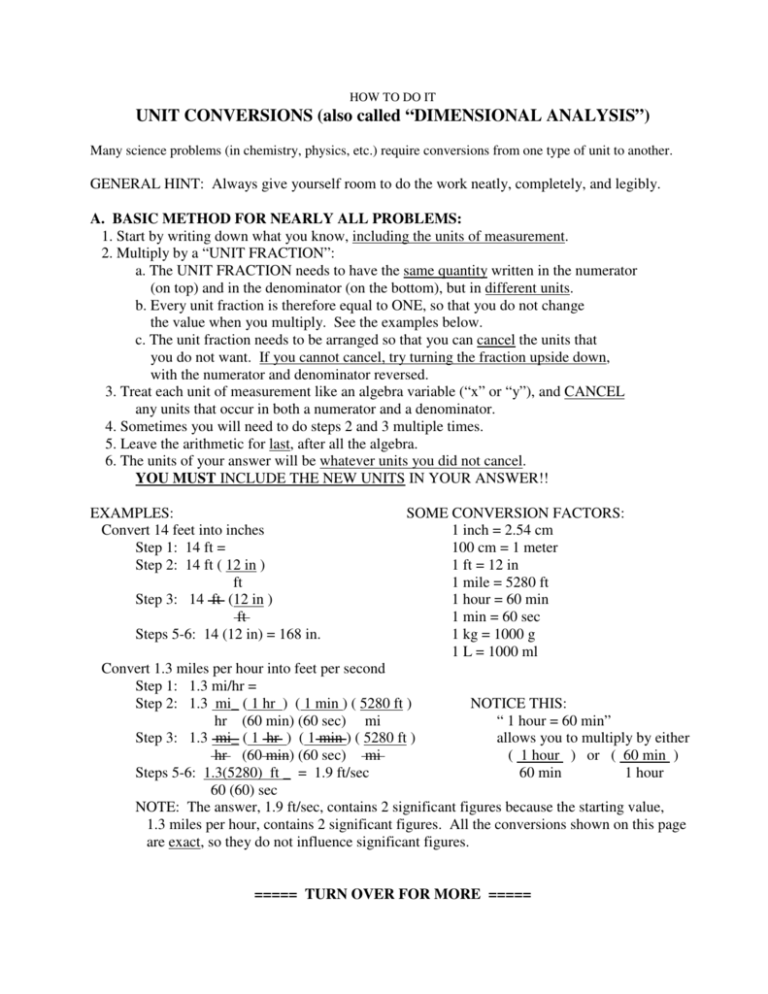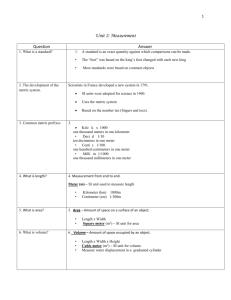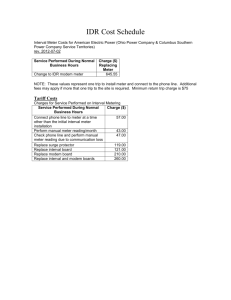UNIT CONVERSIONS (also called “DIMENSIONAL ANALYSIS”)
advertisement

HOW TO DO IT UNIT CONVERSIONS (also called “DIMENSIONAL ANALYSIS”) Many science problems (in chemistry, physics, etc.) require conversions from one type of unit to another. GENERAL HINT: Always give yourself room to do the work neatly, completely, and legibly. A. BASIC METHOD FOR NEARLY ALL PROBLEMS: 1. Start by writing down what you know, including the units of measurement. 2. Multiply by a “UNIT FRACTION”: a. The UNIT FRACTION needs to have the same quantity written in the numerator (on top) and in the denominator (on the bottom), but in different units. b. Every unit fraction is therefore equal to ONE, so that you do not change the value when you multiply. See the examples below. c. The unit fraction needs to be arranged so that you can cancel the units that you do not want. If you cannot cancel, try turning the fraction upside down, with the numerator and denominator reversed. 3. Treat each unit of measurement like an algebra variable (“x” or “y”), and CANCEL any units that occur in both a numerator and a denominator. 4. Sometimes you will need to do steps 2 and 3 multiple times. 5. Leave the arithmetic for last, after all the algebra. 6. The units of your answer will be whatever units you did not cancel. YOU MUST INCLUDE THE NEW UNITS IN YOUR ANSWER!! EXAMPLES: Convert 14 feet into inches Step 1: 14 ft = Step 2: 14 ft ( 12 in ) ft Step 3: 14 ft (12 in ) ft Steps 5-6: 14 (12 in) = 168 in. SOME CONVERSION FACTORS: 1 inch = 2.54 cm 100 cm = 1 meter 1 ft = 12 in 1 mile = 5280 ft 1 hour = 60 min 1 min = 60 sec 1 kg = 1000 g 1 L = 1000 ml Convert 1.3 miles per hour into feet per second Step 1: 1.3 mi/hr = Step 2: 1.3 mi_ ( 1 hr ) ( 1 min ) ( 5280 ft ) NOTICE THIS: hr (60 min) (60 sec) mi “ 1 hour = 60 min” Step 3: 1.3 mi_ ( 1 hr ) ( 1 min ) ( 5280 ft ) allows you to multiply by either hr (60 min) (60 sec) mi ( 1 hour ) or ( 60 min ) Steps 5-6: 1.3(5280) ft _ = 1.9 ft/sec 60 min 1 hour 60 (60) sec NOTE: The answer, 1.9 ft/sec, contains 2 significant figures because the starting value, 1.3 miles per hour, contains 2 significant figures. All the conversions shown on this page are exact, so they do not influence significant figures. ===== TURN OVER FOR MORE ===== B. CONVERSIONS WITHIN THE METRIC SYSTEM (S.I. UNITS): 9 9 Giga- means 10 , so 1 Gm (gigameter) = 10 meter 6 6 Mega- means 10 , so 1 Mm (megameter) = 10 meter 3 3 Kilo- means 10 , so 1 km (kilometer) = 10 meter 2 Hecta- means 100, so 1 hm (hectameter) = 10 meter 1 Deca- means 10, so 1 da m (decameter) = 10 meter 0 Base unit: 1 meter = 10 meter –1 deci- means .1, so 1 dm (decimeter) = 10 meter = .1 m –2 centi- means .01, so 1 cm (centimeter) = 10 meter = .01 m –3 milli- means .001, so 1 mm (millimeter) = 10 meter = .001 m –6 –6 micro- means 10 , so 1 µ m (micrometer) = 10 meter = .000 001 m –9 –9 nano- means 10 , so 1 nm (nanometer) = 10 meter –12 –12 pico- means 10 , so 1 pm (picometer) = 10 meter NOTES: –6 –3 The symbol µ (Greek letter “mu”) means 10 ; do not confuse it with m, which means 10 From “mega” down to “milli”, you can remember the first letters of these words: Kings Have Diamonds, But Diamonds Cost Money (Kilo, Hecta, Deca, Base unit, Deci, Centi, Milli) The same prefixes are used for all metric units, e.g.: 6 3 –3 –6 1 megagram = 10 g, 1 kilogram = 10 g, 1 milligram = 10 g, 1 microgram = 10 g 6 3 –3 –6 1 megaliter = 10 L, 1 kiloliter = 10 L, 1 milliliter = 10 L, 1 microliter = 10 L 6 3 –3 –6 1 megawatt = 10 w, 1 kilowatt = 10 w, 1 milliwatt = 10 w, 1 microwatt = 10 w C. VARIATIONS ON THE GENERAL METHOD: 3 1. Density is expressed in units like g/cm , so you can use density as a conversion factor. 3 3 EXAMPLE: If the density of iron is 7.86 g/cm , then 7.86 g of iron = 1 cm , 3 3 so you can use (7.86 g / 1 cm ) or (1 cm / 7.86 g ) as conversion factors. 2. Atomic weights, molecular weights, and molar masses can all be used to convert grams into moles or moles into grams. EXAMPLE: The molar mass (molecular weight) of H2O is 18.02 g/mol , so you can use any of these conversion factors for water: 1 mol = 18.02 g or ( 18.02 g / mol) or ( 1 mol / 18.02 g) D. TEMPERATURE IS DIFFERENT. Celsius to Fahrenheit: F = 1.8 C + 32 Fahrenheit to Celsius: C = (F - 32) / 1.8 Celsius to Kelvin: K = C + 273 Kelvin to Celsius: K = C + 273 so so so so o o o 100 C is 1.8 (100 C) + 32 = 212 F o o 98.6 F is (98.6 -32)/1.8 = 37 C o o 0 C is 273 K and 100 C is 373 K o 298 K is 298 - 273 = 25 C







